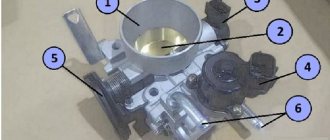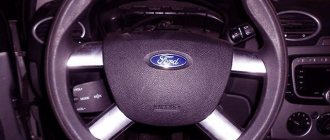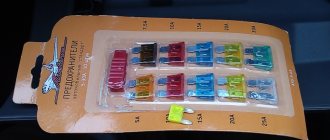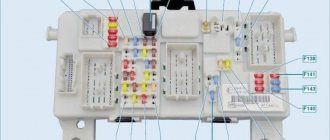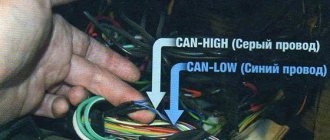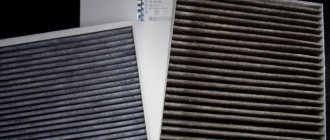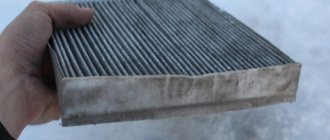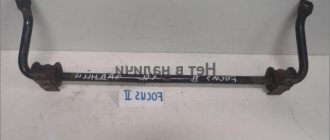Throttle adaptation
- Anonymous
- July 07, 2013
- 17:44
- Anonymous
- July 07, 2013
- 17:44
Well then I don't know =)
- Anonymous
- July 07, 2013
- 17:44
Who knows, I cleaned the damper twice and didn’t remove the terminal. The idle stayed around 1200 and the BC went crazy, but after a kilometer of driving, everything returned to normal.
- Anonymous
- July 07, 2013
- 17:44
let her fuck off, turn it up to 5. I was cured after 10 km
- Anonymous
- July 07, 2013
- 17:44
In short, it’s better not to interfere at all. I pulled off the filter pipe, sprayed it with carburetor cleaner, re-gassed it, tightened the filter pipe and rode on.
- Anonymous
- July 07, 2013
- 17:44
I had to do that, today I drove 100 km, and I gave up and drove smoothly, one dick floats and even stalls, I’ll go to an electrician for an adaptation. I hope it helps
- Anonymous
- July 07, 2013
- 17:44
over time the speed itself will adjust and everything will be fine
- Anonymous
- July 07, 2013
- 17:44
I hope, thank you, otherwise no one undertakes to do the adaptation; I’ve already contacted several services
- Anonymous
- July 07, 2013
- 17:44
[id20446361:bp-6471_141616|Dmitry], what city?
- Anonymous
- July 07, 2013
- 17:44
[id11782596:bp-6471_141628|Lexa], Vladimir, I solved the problem, I’m ashamed to admit, but the chip was not inserted completely (it goes back very tightly)
- Anonymous
- July 07, 2013
- 17:44
What if there is a very good electrician in Murom!
- Anonymous
- July 07, 2013
- 17:44
how to remove the chip from the flap sensor on FF2restai l 1.6 100
- Anonymous
- July 07, 2013
- 17:44
- Anonymous
- July 07, 2013
- 17:44
try prying it off with a screwdriver (my friend and I filmed this way)
- Anonymous
- July 07, 2013
- 17:44
the red tab needs to be pulled out
- Anonymous
- July 07, 2013
- 17:44
[id20446361:bp-6471_141639|Dmitry], I faked it with a screwdriver, it can’t be removed anyway.. it sits tight. or got stuck. and she’s also under the plastic tubes with her hand, you can’t crawl under her
FakeHeader
Comments 27
There is no need to adapt. It adapts itself, just drive a few kilometers. 60-70
Thank you, after traveling the day became much better, now it hardly crashes when starting up
I washed the damper twice and removed it. I didn’t remove the battery clamps, I washed the flap with my fingers. The first time I adapted it in a day, the second time I didn’t think twice about it, I installed it, started it and drove off. No problem. A jump in rpm to 2000 at startup is possible due to the firmware. This effect, as I read, occurs on icebreaker firmware. I also have such a jump, but it doesn’t bother me.
can you tell me more about the firmware? Before cleaning this did not happen, it immediately reached the required speed. It would be nice if it was just a jump, then the needle hangs for a while and slowly goes down, the same symptoms when in neutral
Look at the FF club, it’s a chore to write through a mobile phone. There are not many trains; if, due to a large amount of soot, the brains have developed their own tuning algorithm, it takes time to adapt. After all, your brain adapts even to your driving style, it takes time.
Had the same “problem”. But for my Funtik to adapt again, it took about a week of driving.
I think it all depends on the mileage, some cover 5 km a day and others 50, approximately how much did you cover in a week?
Decently, about 500 km... I already began to rack my brains about what to do. It is possible that this happened due to the fact that it had not been cleaned for a long time before.
As far as I remember, there is no need to train anything; training and adaptation takes place while driving. It was about the same thing when I removed the battery for preventative maintenance, the car sat for a day without a battery, then after I installed it, started it, some strange things started, the speed fluctuated, the dynamics were so-so, after about 50 km. everything settled down and returned to normal. I think in your case everything is identical. I have FF3.
The same thing, the dynamics have changed a little, it’s good if so, otherwise I’m already preparing for the worst, I’m thinking about taking everything off again, changing the gasket, checking all the hoses and pipes)
then be patient a little)) it will pass
Closer to the end
I did exactly what he recommended and it didn’t help.
If - you didn’t touch the “black” box, you didn’t touch the adjusting screw, you didn’t break anything else -
self-learning will take place automatically
100-200 km or a day of driving, this happened to me 3 times (/30,000 km). I really didn’t remove the terminal - but you disconnect the module (damper) when you turn off the ignition - and when you then turn on the ignition switch - the system is polled and the algorithm is selected
Alternatively, wash it poorly (a piece of dirt is on the damper shaft) / drive it further / stretch it (is there any air leakage under the gasket?
I hope - soap with removal - aerosol cleaner to clean the carburetor...
I didn’t touch the black box, I didn’t twist the screws, I removed it and cleaned it with an aerosol carburetor cleaner, I rubbed it in places with a toothbrush because it was very dirty, and I opened the valve itself with my fingers, I didn’t change the gasket, I just wiped it with a cloth
If - you didn’t touch the “black” box, you didn’t touch the adjusting screw, you didn’t break anything else -
self-learning will take place automatically
100-200 km or a day of driving, this happened to me 3 times (/30,000 km). I really didn’t remove the terminal - but you disconnect the module (damper) when you turn off the ignition - and when you then turn on the ignition switch - the system is polled and the algorithm is selected
Alternatively, wash it poorly (a piece of dirt is on the damper shaft) / drive it further / stretch it (is there any air leakage under the gasket?
I hope - soap with removal - aerosol cleaner to clean the carburetor...
And if you touched the black box while inspecting the remote control position sensor for abrasion of the graphite track?
Throttle learning
Throttle learning is a technical term that owners of modern vehicles have recently become familiar with. This procedure is carried out on cars equipped with an ECU (electronic control unit) in case of unstable engine idling for a number of reasons, which will be discussed below.
The first ECUs (or controllers) began to be installed back in the late 80s. In this case, the opening of the throttle angle (TA) depended on signals from the sensors and the position of the gas pedal, which changed along with the force the driver pressed the pedal.
Modern cars are equipped with electronic accelerators on which electronic sensors are installed. It is from them that data on the degree of pressure (angle) on the accelerator is read. The corresponding information is supplied to the control unit. However, remote control training is also carried out on cars equipped with gas pedals that transmit force to the throttle valve mechanically.
Most modern cars made in Europe, America and Japan have both systems installed.
Signs of throttle adaptation
The throttle valve in its modern form is one of the last components to undergo electronic modernization. Instead of mechanical rods, a compact electric motor is installed on it, which serves as an actuator.
The signal to it comes directly from the throttle sensor. Together, this system allows you to control the engine correctly, supplying the required volume of fuel mixture to the combustion chambers in a timely manner. There are several signs by which you should start adjusting the throttle position.
For example, when you suddenly release the gas pedal, the engine does not go to idle and stalls; the following can also happen:
- Unstable engine operation at idle;
- a significant “freezing” of revolutions around the 1.5 thousand mark;
- drops in speed when gaining power;
- the “CHECK ENGINE” indicator lights up on the dashboard;
- difficult start at ;
- lack of response when pressing the gas pedal.
Depending on the engine type, there may be a slight loss of power, for example with engines with a V8 configuration. Also, fuel consumption almost always increases. These signs appear especially often on cars with a mileage of 30 thousand km or more, equipped with turbocharging.
The most common reason for an adaptation to be made is the consequences of throttle valve maintenance. As a result of operation, a large amount of deposits forms in this unit, therefore, after flushing, the position of the throttle valve changes, and the ECU continues to send signals about its condition until maintenance.
Over time, natural wear occurs on the resistive layer of the sensor potentiometer and the moving elements of the throttle valve; in this case, after adaptation, it will most often require replacement. It is necessary to conduct training if changes are made to the ECU settings (chip tuning), especially if operations have been performed to increase engine power.
The procedure is performed using special programs on computer equipment or without them (a strictly defined procedure, which will be discussed below) depending on the brand of car. Auto electricians must take into account the features of the model, year of manufacture, and type of ECU installed on the vehicle.
Setting the gas pedal on a Ford Focus 2
Hello everyone! I hardly believe it, but suddenly. I really need help
